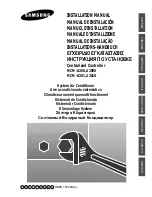
Operation manual
13
ERAP110~170MBYNN
Air-cooled condensing units
4PW22681-1
T
ROUBLESHOOTING
This section provides useful information for diagnosing and
correcting certain troubles which may occur in the unit.
Before starting the troubleshooting procedure, carry out a thorough
visual inspection of the unit and look for obvious defects such as
loose connections or defective wiring.
Before contacting your local dealer, read this chapter carefully, it will
save you time and money.
Overview of safety messages
When a safety device was activated, stop the unit and find out why
the safety device was activated before resetting it. Under no
circumstances safety devices may be bridged or changed to a value
other than the factory setting. If the cause of the problem cannot be
found, call your local dealer.
Symptom 1: The unit does not start, but the ON LED lights up
Symptom 2: The unit does not start, but the ON LED is flashing
Symptom 3: The unit does not start and the ON LED does not light up
3
Symptom 4: The circuit does not start up
Symptom 5: One of the following safety devices is activated
5.1
5.2
5.3
5.4
When carrying out an inspection on the supply panel or on
the switch box of the unit, always make sure that the circuit
breaker of the unit is switched off.
Message safety menu
Symptom
##
#
#*
#8
2
-
"
2
!
8
8
*2$
*!$
#
P
OSSIBLE
CAUSES
C
ORRECTIVE
ACTION
All thermostat contacts are open.
Check the thermostat contacts.
The flowstart timer is still running.
The unit will start after approx. 15
seconds. Make sure that the cooling
source is flowing over/through the
evaporator.
The circuit can not start up.
Refer to
Unit is in manual mode (all
compressors at 0%).
Check on the controller.
Power supply failure.
Check the voltage on the supply
panel.
Blown fuse or interrupted protection
device.
Inspect fuses and protection
devices. Replace by fuses of the
same size and type (refer to
"Electrical specifications" on
page 1
Loose connections.
Inspect connections of the field
wiring and the internal wiring of the
unit. Tighten all loose connections.
Shorted or broken wires.
Test circuits using a tester and repair
if necessary.
P
OSSIBLE
CAUSES
C
ORRECTIVE
ACTION
The remote ON/OFF input is
enabled and the remote switch is off.
Put the remote switch on or disable
the remote ON/OFF input.
P
OSSIBLE
CAUSES
C
ORRECTIVE
ACTION
The unit is in failure mode.
Refer to
following safety devices is activated
One of the following safety devices is
activated:
• Air- or waterflow contact (S9L)
• Emergency stop
Refer to
following safety devices is activated
The ON LED is broken.
Contact your local dealer.
P
OSSIBLE
CAUSES
C
ORRECTIVE
ACTION
One of the following safety devices is
activated:
• Compressor thermal protector (Q*M)
• Overcurrent relay (K*S)
• Discharge thermal protector (S*T)
• Low pressure
• High pressure switch (S*PH)
• Reverse phase protector (R*P)
Check on the controller and refer to
Symptom 5: One of the following
safety devices is activated
.
The anti-recycling timer is still active.
The circuit can only start up after
approximately 10 minutes.
The guard timer is still active.
The circuit can only start up after
approximately 1 minute.
The circuit is limited.
Check the enable/disable capacity
limitation remote contact.
Symptom 5.1: Overcurrent relay of compressor
P
OSSIBLE
CAUSES
C
ORRECTIVE
ACTION
Failure of one of the phases.
Check fuses on the supply panel or
measure the supply voltage.
Voltage too low.
Measure the supply voltage.
Overload of motor.
Reset. If the failure persists, call your
local dealer.
RESET
Push the blue button on the over-
current relay inside the switch box
and reset the controller.
Symptom 5.2: Low pressure
P
OSSIBLE
CAUSES
C
ORRECTIVE
ACTION
Air- or waterflow to heat exchanger
too low.
Increase the air- or water flow.
Shortage of refrigerant.
Check for leaks and refill refrigerant,
if necessary.
Unit is working out of its operation
range.
Check the operation conditions of
the unit.
RESET
After pressure rise, this safety resets
automatically, but the controller still
needs to be reset.
Symptom 5.3: High-pressure switch
P
OSSIBLE
CAUSES
C
ORRECTIVE
ACTION
Condenser fan does not operate
properly.
Check that the fans turn freely. Clean
if necessary.
Dirty or partially blocked condenser.
Remove any obstacle and clean
condenser coil using brush and
blower.
Inlet air temperature of the
condenser is too high.
The air temperature measured at the
inlet of the condenser may not
exceed 43°C.
Fan turning in the wrong direction.
Two phases of the power supply to
the fan motor must be inverted (by a
licensed electrician).
RESET
After pressure decrease, push the
button on the high-pressure switch
and reset the controller.
Symptom 5.4: Fan thermal protector is activated
P
OSSIBLE
CAUSES
C
ORRECTIVE
ACTION
Mechanical failure (fan is blocked).
Check that the fan rotates freely.
Air flow in the unit too low or outdoor
temperature too high.
Clean the air heat exchanger
properly.
RESET
After temperature decrease, the
thermal protector is reset
automatically.
If the protector is activated
frequently, replace the motor or call
your local dealer.




































